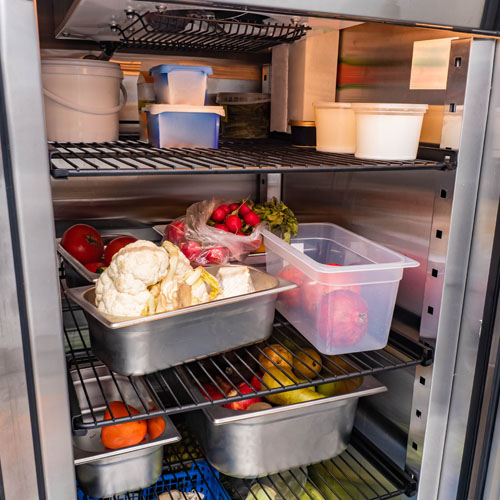Fridges should operate at 1–5 °C and no higher than 8 °C. If these conditions aren’t met because the appliance has a fault, for instance, and the food rises to above 8 °C for a sustained period (4 hours) then it must be thrown away. Freezers keep food for longer and so must operate below –18 °C.
To ensure food produce is safe to eat, companies must check and record the temperature of their fridges and freezers daily to ensure that they are working correctly and to comply with safety standards – such as HACCP.
This is a really important safety measure, however, it’s also a burden as much of the monitoring takes place manually. What is more, this is problematic for staff as there are often many other important activities that must be undertaken daily.
Chris Potts (pictured), Marketing Director at ANT Telecom, explains how food companies can comply with HACCP regulation and streamline this operational process with automation, digitisation and IoT.
IoT Sensors can help food companies enhance time consuming and arduous processes. Not only does this help to free up valuable resource, it provides accurate and reliable real-time data 24/7 that helps organisations reduce costs and save money.
Temperature monitoring
Using sensor technology is not new but a lot of sensors are typically hardwired, which makes them difficult and expensive to install. Additionally, when installed, some cable probes may need to be fed through seals in fridge doors.
This isn’t ideal as it can leave a gap to let cold air out and warm air in, affecting the temperature of the appliance and contents within.

Therefore, wireless sensors are easier to install; but they require connectivity. Generally, Bluetooth and WiFi sensors aren’t suitable in these kinds of applications.
This is because batteries don’t last long and many commercial fridges and freezers are like large metal boxes that mobile signals do not penetrate.
Effective temperature sensors
In contrast, LoRaWAN technology and its compatible sensors offer a more versatile, effective answer. These low powered, long range wireless sensors are perfect for measuring fridge/freezer temperatures.
This is because data can be transmitted up to 12 km away (direct line of sight).
Therefore, with such a long range, the LoRaWAN radio waves are designed to be able to permeate through the seals in the appliances, making it possible to cover large sites and distances, with a small number of 4G/LAN gateways that upload the sensor data to a secure online portal.
Batteries can last 2–3 years before replacing too.
Data analysis, dashboards and insights
Today, most online portals can be accessed from any web browser on a PC, laptop, and smartphone. The applications are generally easy to use and provide operational and management teams a dashboard of key information that they can view centrally and in real time.
Each sensor can also be labelled and entire site maps, along with images, can be logged to match sensors according to the relevant appliance, to help distinguish them from one another.
Trend analysis is also possible. Teams can see historic information displayed in a chart, showing how temperatures vary through the day, week and month. This can draw attention to anything unexpected or out of the ordinary that could affect food quality or safety.
Avoiding threshold breaches ... and improved reporting
By using sensors and online portals in tandem temperature thresholds can be set to notify organisations if there is an issue that needs to be investigated.

So, for instance, teams may wish to know if a freezer rises above –18 °C for more than 20 mins, as this could indicate a fault with an appliance and affect food quality and safety.
An early warning will help move the contents to another freezer to avoid food being thrown away unnecessarily, along with the huge expense of replacing all the contents.
Further, the online data collected by the sensor will provide 100% proof and peace of mind that any food moved is still safe to eat, providing a useful digital “paper trail” when necessary.
Additionally, since data is stored automatically and in a report format, organisations will no longer need to create paper-based records and manually input data to generate weekly/monthly reports for auditing and compliance purposes.
Automating this piece with digitisation is saving time, reducing costs for organisations, and is more accurate.
Starting small and scaling
For many organisations the idea of taking on an IoT related project is daunting. Some companies are set in their ways and slow to change. Therefore, its advised to trial a proof of concept develop a scalable set up that consists of a small number of sensors that can be added to with time.
This makes it possible to monitor other conditions such as power (on/off) and energy usage of appliances, or how often the fridge door is opened.
The benefit of monitoring energy, for instance, can help organisations to reduce their energy bills as a poorly functioning unit can consume 100% more energy than a well maintained unit.
Conclusion
Manually monitoring and recording the temperature of fridges and freezers for quality, safety and compliance can be very time consuming and isn’t always accurate and reliable.
Using an IoT monitoring solution is far more reliable and cost effective. Continual monitoring provides insight on how temperature can vary and help improve food quality.
Early warnings of temperature breaches will help to move food, reducing waste and costs. Furthermore, auto-generated reports will help businesses fulfil compliance obligations (HACCP) efficiently.
